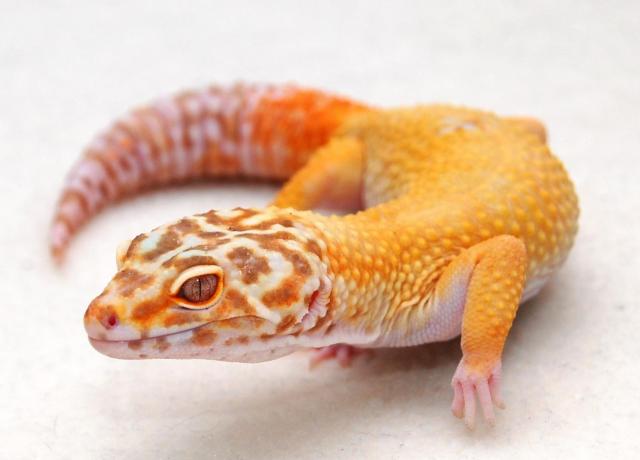Obesity is a growing problem for pet leopard geckos just as it is for humans. An overweight leopard gecko may have health issues and a shortened lifespan. As a responsible pet owner, it’s important to monitor your leopard gecko’s weight and take action if needed to get them to a healthy size. This article will cover how to tell if your leopard gecko overweight, the causes and health risks of obesity, and tips for helping an obese leopard gecko lose weight safely.
How to Tell if Your Leopard Gecko is Overweight
Determining if your leopard gecko is at a healthy weight takes some

observation. Here are signs that your leopard gecko may be overweight or obese:
- Fat deposits visible around the neck, armpits, and thighs
- Bulging waistline when viewed from above
- Difficulty fitting inside hides
- Reluctance to move around the tank
- Lethargy and tiredness
- Heavy breathing or open-mouth breathing
- Tail is as wide as the neck or wider
A healthy leopard gecko has a streamlined body shape. From above they should have an hourglass figure, with a narrow waist between broader upper body and hips. Their tail should also be thinner than their neck. Fat deposits on an overweight leopard gecko are most visible around the armpits and thighs.
Use your best judgment based on your leopard gecko’s body proportions. Take note if your gecko is showing signs of low energy or labored breathing in addition to weight gain. These are clues that excess fat is impacting their health.
Causes of Obesity in Leopard Geckos
Leopard geckos become overweight for the same reasons that cause obesity in other animals: taking in more calories than they burn through activity and metabolism. Some specific factors that can lead to leopard gecko obesity include:
- Overfeeding: Providing too much food is the most common cause of an obese leopard gecko. Geckos are opportunistic eaters and will continue eating as long as food is offered.
- Limited space: Leopard geckos in small enclosures without sufficient room to exercise are prone to weight gain.
- Improper diet: Diets high in fat and low in key nutrients can promote obesity. Mealworms are a common culprit.
- Medical conditions: Certain health issues like fatty liver disease can cause weight gain in leopard geckos.
- Age: Middle-aged and senior leopard geckos tend to be less active and have slower metabolism.
Any leopard gecko can become overweight, but the risk is higher if they are fed improper diets, inactive, or have an underlying medical issue causing weight gain.
Health Risks of Obesity in Leopard Geckos
Carrying excess body fat puts leopard geckos at risk for developing:
- Respiratory problems: Excess fat in the chest cavity can make breathing difficult. Overweight leopard geckos may breathe with their mouths open or make wheezing noises.
- Heart disease: Obesity stresses the heart and cardiovascular system. Fatty plaques can build up in blood vessels over time.
- Diabetes: Excess sugar and fat intake can cause insulin resistance and diabetes in leopard geckos as it does in humans.
- Fatty liver disease: A buildup of fat cells in the liver prevents it from functioning normally. This can be fatal if left untreated.
- Joint pain: Extra body weight puts strain on the joints and can cause painful arthritis over time, especially in the hips and back legs.
- Reduced lifespan: On average, obese leopard geckos live 2-3 years less than geckos kept at a healthy weight.
Letting a leopard gecko remain overweight severely impacts their health and quality of life. Consulting an exotic vet if your pet gecko shows concerning weight gain is recommended.
Tips for Helping an Overweight Leopard Gecko Lose Weight
Getting an obese leopard gecko to lose weight requires an intentional diet and exercise plan. Here are some tips:
- Gradually reduce food: Slowly cut back on feedings and portion sizes over time rather than putting your gecko on a crash diet. This allows their metabolism to adjust.
- Focus diet on insects: Feed more insects like crickets, roaches, and worms which are lower in fat than meatier options. Gut load insects with healthy fruits and vegetables.
- Limit fatty prey: Reduce high-fat prey like waxworms, butterworms, and pinky mice which can pack on the grams. Think of these as ‘treats’ rather than staples.
- Add more low-calorie foods: Offer more low-calorie options like leopard gecko MRP powder mixed with water or shakes. You can also try mealworm pupae, silkworms, hornworms, shrimp, and cockroaches.
- Increase exercise opportunities: Make sure your leopard gecko has a large enough enclosure, at least 20 gallons long for an adult. Add extra climbing areas, rocks, branches, and hide boxes spread out to encourage movement.
- Handle your gecko daily: Take your leopard gecko out for at least 20-30 minutes of supervised handling per day. Gently encourage walking rather than having them stay still in your hands.
- Consult an exotic vet: Get guidance from a veterinarian experienced in reptile care. They can identify any underlying medical issues and ensure weight loss is done safely.
With a steady, health-focused diet and increased daily activity, most obese leopard geckos can successfully shed excess weight and keep it off long-term. Be patient – losing weight takes time for leopard geckos just as it does for people. Consistency with new leopard gecko diet and exercise routine is key.
Conclusion
Keeping your leopard gecko at a healthy weight is one of the best things you can do as a pet owner to support their wellbeing. Pay attention for signs of obesity like fat deposits, lethargy, and labored breathing which indicate your gecko has become overweight. Work on gradually reducing food intake and increasing exercise opportunities. Get your exotic vet involved to ensure any weight management plan is tailored appropriately for your leopard gecko. With your help, even an obese leopard gecko can achieve better health through safe, effective weight loss.
FAQs About Leopard Gecko Overweight
What are the common causes of leopard gecko obesity?
Leopard gecko obesity is often caused by overfeeding and offering high-fat or sugary foods. Feeding frequency and portion sizes contribute to obesity. Additionally, lack of physical activity and an inadequate habitat can lead to weight gain in captivity.
How can I help my overweight leopard gecko lose weight safely?
To help an overweight leopard gecko lose weight safely, adjust its diet by offering appropriate-sized prey insects and reducing feeding frequency. Ensure the gecko has a well-structured enclosure with hiding spots and opportunities for exercise. Consult a reptile veterinarian for personalized guidance and monitoring during the weight loss process.
What is the ideal diet for a leopard gecko to prevent obesity?
The ideal diet for a leopard gecko includes appropriately-sized live insects such as crickets, mealworms, and roaches. Avoid fatty insects like waxworms and limit treats. Offer a calcium supplement and ensure a balanced diet. Adjust feeding frequency based on age and activity level to prevent overfeeding and obesity.
Can an overweight leopard gecko’s weight loss be monitored at home?
Yes, you can monitor an overweight leopard gecko’s weight loss at home. Use a digital kitchen scale to regularly weigh the gecko, ideally once a week. Keep a record of its weight and observe any gradual decreases. Consult a reptile veterinarian if weight loss is not occurring as expected.
Are there any specific exercises or activities to help an overweight leopard gecko become more active?
Leopard geckos are not particularly active reptiles, but you can encourage activity by providing an enriched enclosure with hiding spots, climbing opportunities, and obstacles. Occasionally, offer live prey that requires hunting. Ensure the gecko can access its basking and cool areas easily, promoting movement and activity.



